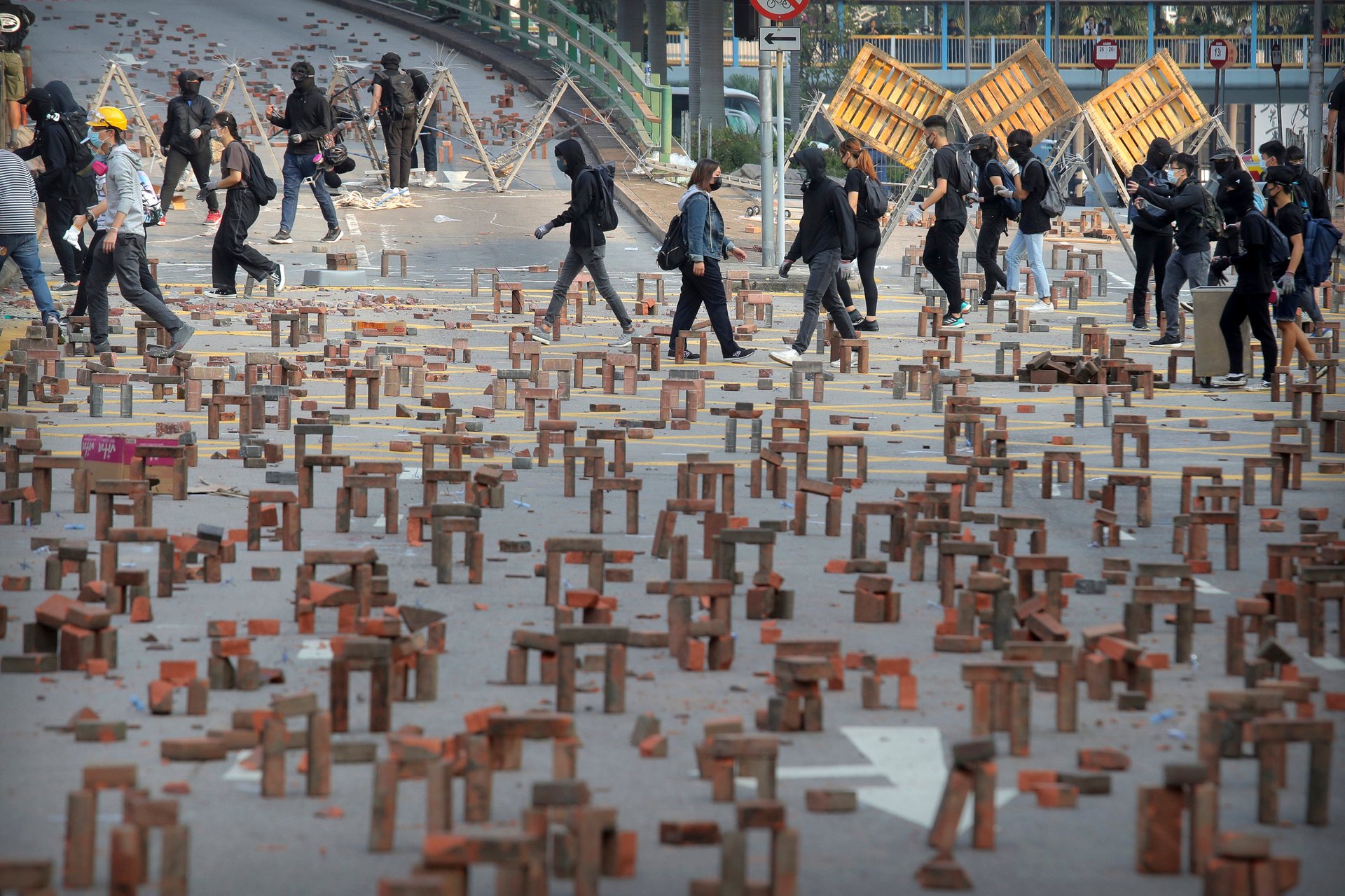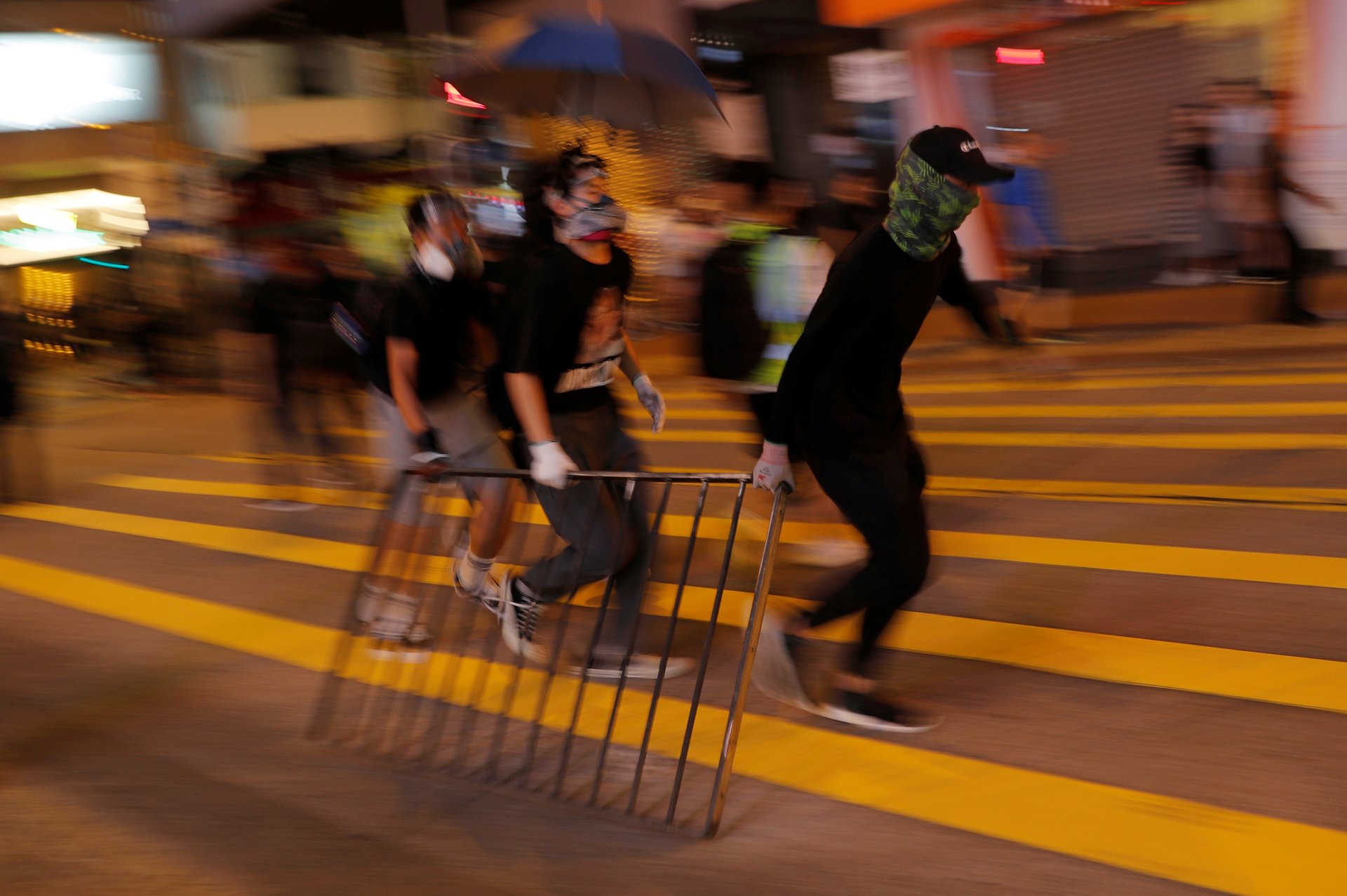From sidewalks to shopfronts, Hong Kong’s protests have rearranged its urban landscape
Six months of protests in Hong Kong have, for better or worse, remade the design of the city. The rough contours of the anti-government movement are visible everywhere.


Six months of protests in Hong Kong have, for better or worse, remade the design of the city. The rough contours of the anti-government movement are visible everywhere.
Public spaces whose roles few typically question have all suddenly become sites of protest: shopping malls, underpasses, bridges, freeway columns, tram stops, and even roadway medians. Bricks and bamboo poles, typically used on construction sites and for scaffolding, have been fashioned into makeshift barricades by protesters.
The reconfiguration of these mundane sites into spaces of political expression show how Hong Kong’s public space “is clearly made by the people, not something simply given by the state, and certainly not to be taken for granted,” said Jeff Hou, a professor of landscape architecture at the University of Washington and the co-editor of City Unsilenced: Urban Resistance and Public Space in the Age of Shrinking Democracy.
The various ways in which protesters have molded existing spaces for new uses, in defiance of norms and regulations, parallel their calls for greater democracy. Hou sees in protesters’ interaction with the city opportunities for a more democratized form of urban design, especially given that public participation in Hong Kong’s urban planning is considered by some to be insufficient (pdf).
The protests, he said, “show us the capacity of citizens in designing the city. If people can be enormously creative and capable during the protests, surely they have the ability to participate in making planning and design decisions.”
Unfencing the sidewalks
Perhaps the most obvious change to the urbanscape is the disappearance of thousands of gray metal fences that used to line large swathes of sidewalks, and were intended to prevent people from crossing or stepping into the street, except at designated spots. While many of those fences are still there, some 45 kilometers (28 miles) of railings were dismantled, often times by protesters armed with Allen keys and fashioned into makeshift barricades, but also pre-emptively by the city.
Suddenly, the narrow sidewalks are much more open: people can fan out more evenly, preventing bottlenecks from forming at crosswalks. Where the fences used to be, there are now lone poles jutting out from the ground, sometimes topped with a tennis ball or wrapped with tape to cover sharp edges.
For urban-design advocates, the removal of so many railings has been an unexpected godsend—something they’ve long argued for to make streets more walkable in a city that often prioritizes cars in planning. In some cases, the city has tried to recreate the barriers by linking poles with plastic ribbon, but Designing Hong Kong, a nonprofit focused on urban design issues, is urging the government not to re-install the railings.
“Why spend money to put them back? You’re basically giving weapons to the protesters,” said Paul Zimmerman, co-founder and CEO of the group, and who also serves as a local district councilor. He acknowledged that the railings can stop people from crossing at accident-prone trouble spots, but believes pedestrians should be trusted to choose where and when to cross.

For Paul Chan, co-founder and CEO of local walking tour group Walk in Hong Kong, the restrictions posed by the barriers connect in more than a physical way to the protest movement. “The railings are very metaphorical. If it wasn’t for these protests, I wouldn’t stop to think about these prisons,” he said, comparing the railings to restrictive frameworks of rules and regulations that the government sets out for citizens. “But is the frame itself what’s holding back the city from moving forward?”
Hong Kong’s defensive new look
As protesters turned to more aggressive tactics, including the targeted vandalism of metro stations and businesses with close ties to China, defensive measures have sprung up that stand out in a city of glass and neon.
Many subway station entrances that used to feature glassy, transparent facades are now clad in shiny opaque metal sheets, making for a futuristic spaceship-like aesthetic. Other stations are encased in dark iron boards, giving off an ominous feel—until protesters plaster the new canvas with colorful art again. Banks and shops have covered their glass windows with white, or sometimes black, board. At some stations, protest graffiti is covered up with white plastic sheets, only for more graffiti to be scribbled on the new surface, then subsequently covered up again with a patchwork of tape in a constant process of inscribing and scrubbing, doing and undoing.
These markings throughout the city tell an important story, even if they may be eyesores to some, said Chan, of the walking tour group. Undoubtedly, pavements left potholed from dug-up bricks present obstacles to some pedestrians, especially the elderly or those accompanying children in strollers, while traffic lights damaged by protesters present safety hazards. The challenges are particularly pronounced for the visually impaired, who must now navigate without the guidance of ticking traffic lights and pick their way along debris-strewn streets.
Still, the physical damages present an opportunity to reckon with the legacy of the protests. ”Should we wipe away all these scars, or treat them as a part of the city’s history, as an important heritage?” Chan said, adding that vandalism, despite being a destructive act, is also a “phenomenon” that should be reflected in the cityscape. “If this kind of damage appears in the city, should we not explore why people felt the need to do what they did?”
For now, the protests continue, and so does the reconfiguration of urban space—and memory. Moments of protest are now recalled as city “landmarks”: here’s where a protester was shot, here’s where someone stood with an iconic banner, and over there is where a teargas canister landed dangerously close to someone.
Even if the protests retreat from the streets, they will have etched indelible marks on the city’s landscape. On one sidewalk in the city’s business area, fresh cement had been poured to fill holes where protesters had dug up bricks, only for someone to scrawl “Free HK” before it set, immortalizing an act of resistance that the government tried to cover it up.
“At the end of the day, the protests change the narration of the city,” said Tali Hatuka, director of the Laboratory of Contemporary Urban Design at Tel Aviv University and the author of The Design of Protest. “They are aiming at reconstructing the story of the place by adding missing components and emphasizing neglected parts. Even after the events the images of the events will remain in the collective memory of the society.”